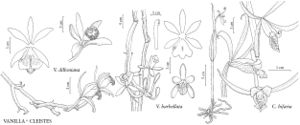Cleistes
Gen. Sp. Orchid. Pl., 409. 1840.
| Taxon | Illustrator ⠉ | |
|---|---|---|
 | Vanilla dilloniana Vanilla barbellata Cleistes bifaria | Barbara Alongi Barbara Alongi Barbara Alongi |
Herbs, terrestrial. Roots 1–2 mm wide, sometimes with wider nodular tuberoids, frequently rather brittle. Leaves 1–3 on vegetative plants, 1 (–2) centrally on flowering-stems, sessile; blade oblong-lanceolate or elliptic-oblong. Inflorescences terminal,1–3-flowered; floral bracts leaflike. Flowers resupinate, erect, sessile; sepals olive-green, brown, or maroon, linearlanceolate, apex acuminate; petals rose-pink to white, spatulate or oblanceolate, usually forming tube with lip; lip rose-pink to white, with rose or purple veins, oblanceolate, 3-lobed, middle lobe medially winged or tuberculate, central keel grooved from base to 3/4 its length; column free, white, apex lacerate, truncate; anther terminal, hinged; pollinia 2, without viscidium, soft, mealy; pollen-grains in tetrads. Fruits capsules, erect, cylindric.
Distribution
Tropical and subtropical regions, mostly South America, 2 in Central America
Discussion
Species ca. 25 (2 in the flora).
Authors of some neotropical floras have questioned the separation of Cleistes from Pogonia; most recent North American authors have followed O. Ames (1905–1922) in recognizing Cleistes, and we prefer to do the same until a detailed study suggests otherwise. The two North American species can reproduce asexually by root shoots.
Selected References
None.
Lower Taxa
Key
| 1 | Column 13–19 mm; lip 21–33(–38) mm. | Cleistes bifaria |
| 1 | Column 21–25(–29) mm; lip (26–)34–55 mm. | Cleistes divaricata |
"/4" is not declared as a valid unit of measurement for this property.